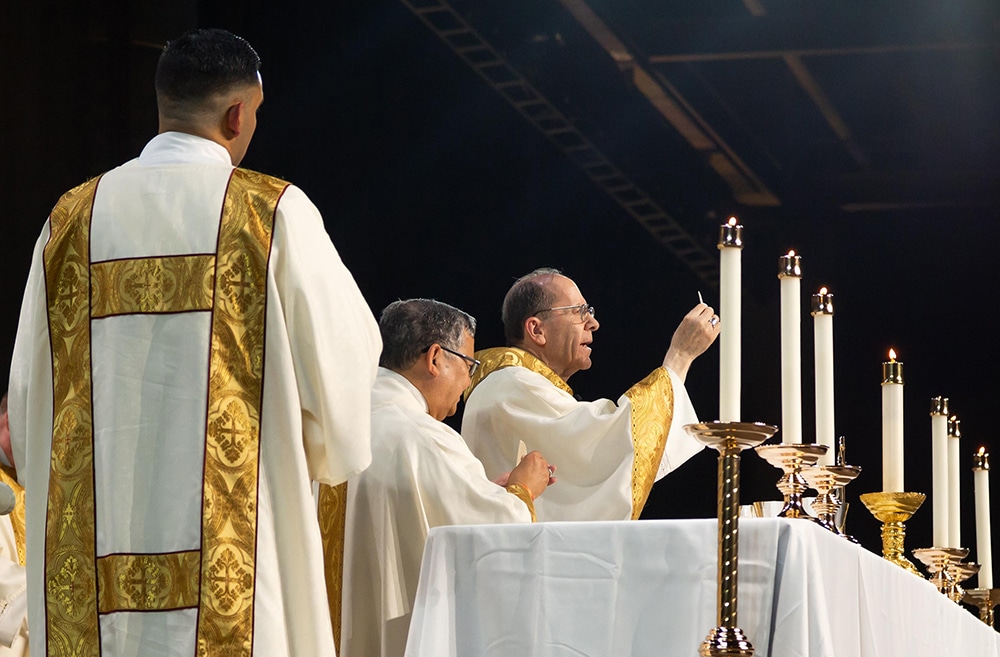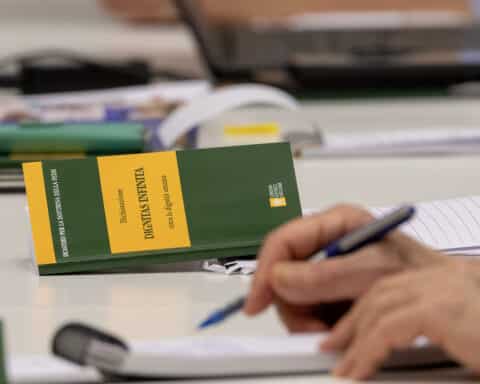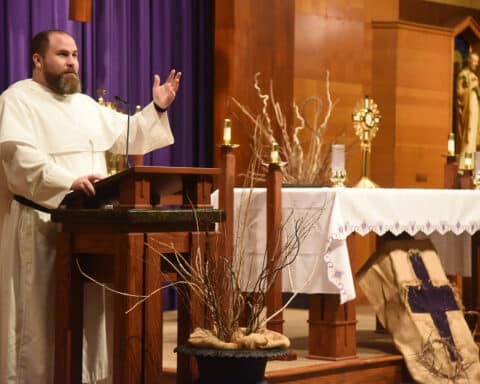The same Jesus who walked the Palestinian countryside, who preached, cured the sick and raised the dead “is truly present” in the Eucharist, Bishop Thomas J. Olmsted of Phoenix emphasizes in a new apostolic exhortation.
“I think the Eucharist is what we need to focus on. This is the gift he left to the Church. It is the way he remains present with us,” Bishop Olmsted said in a webinar on Holy Tuesday, two days before the release of “Veneremur Cernui — Down in Adoration Falling.”
Released on Holy Thursday, Bishop Olmsted’s third apostolic exhortation is a 14,000-word document that delves into the history, theology and centrality of the Eucharist to the Catholic faith. Citing Scripture and quoting Church Fathers and other saints, the bishop writes that “the greatest anchor” Christians have in the midst of modern turmoil is “Christ Himself, found in the Holy Eucharist.”
“Jesus is the king of the universe, and he is truly present in every one of our Catholic churches in the tabernacle. What an incredible blessing,” Bishop Olmsted said in last week’s webinar.
But if recent public opinion polls are any indication, a large majority of Catholics no longer believe in the Real Presence. A 2019 Pew Research Center, for example, found that 70 percent of Catholics believe the Eucharist is only symbolic of Jesus’ body and blood.
Though raising doubts about the accuracy of such surveys, Bishop Olmsted said in the webinar that “it is very problematic” if Catholics do not have “a real sense that the personal presence of Jesus is with us in our churches in the Eucharist.” The bishop described the Real Presence as a “great treasure” waiting to be found, or rediscovered.
Bishop Olmsted said his new exhortation is meant to help Catholics appreciate “even more this great blessing, this great gift to the Church, really a gift to the world, that is the body and blood of Jesus Christ, in the most perfect worship we can offer to the Father.”
In the exhortation, the bishop calls upon priests and laity to a greater recognition and appreciation for the Eucharist as the source and summit of the Catholic faith and Christian life, which he writes was first inculcated in him through the faith-filled example of his parents.
“The way my father genuflected before the Tabernacle, the quiet reverence of my mother, the way our pastor Father Daly sang the Tantum Ergo with such gusto and a thick Irish brogue, it was these actions and God’s grace, more than words, that imbedded in my heart a solid conviction about the real presence of Jesus in the Eucharist,” Bishop Olmsted writes.
Taking its name from the Tantum Ergo hymn composed by St. Thomas Aquinas, “Veneremur Cernui — Down in Adoration Falling” is comprised of 111 paragraphs, divided in three parts, that present the historical and Scriptural context for the Eucharist and holy Communion’s role as the sacrament of Christ’s love, while offering advice on how Catholics can cultivate greater devotion for the Eucharist in their own spiritual lives.
Part I describes how Christ, when he instituted the Eucharist at the Last Supper, “forever transformed” the Jewish Passover ritual meal. It is in the Passover, the bishop writes, where “we see the context in which Jesus desires His Body and Blood to be consumed as food.”
“This is the context where we discover the beauty of the grand mystery of the Eucharist as the fulfillment of both the Jewish Passover and the Covenant of Israel,” the bishop writes.
In Part II, Bishop Olmsted reflects on the Eucharist as “truly the sacrament of Christ’s love,” and he encourages the faithful to imitate Jesus, who held nothing back on the Cross, and “to go all out” in responding to “Jesus’ most extravagant gift of himself.”
“The only appropriate response to this great gift is to order our whole life, first, on receiving the gift and then imitating it, offering our own body and blood, our sweat and tears, our whole heart, all we have and are to Jesus in the service and love for our brothers and sisters as Jesus has done for us,” the bishop writes.
The bread and wine that are transformed into the body and blood of Christ are also “powerful symbols” that the bishop says “convey eloquently” the Lord’s invitation to walk his path of self-sacrificial love. The grains of wheat are plucked, trashed, crushed, ground up, kneaded and shaped before being thrown into a baking oven. In a similar way, the grapes used for wine are plucked and smashed, their juice purified.
Writes Bishop Olmsted, “If we look up at the Crucified Jesus on the Cross, we can see a similar grueling process He went through in His Passion and Death.”
The bishop offers practical suggestions in Part III for how clergy and the lay faithful can cultivate a deeper love for the Eucharist, including attending daily Mass, organizing annual Eucharistic processions, spending regular time in adoration, praying often before the tabernacle and keeping Sunday as a Sabbath day of rest and prayer.
Writes Bishop Olmsted: “May we never tire of discovering that the Eucharist is the source and summit of Christian life! As from the source of a great river, everything that matters in life flows from it. As to a great mountain peak, all the striving and struggle of life seeks it.”
Brian Fraga is a contributing editor for Our Sunday Visitor.





